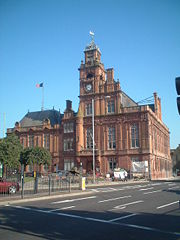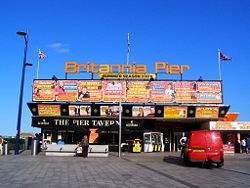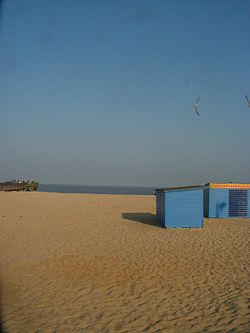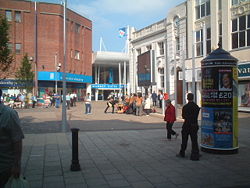Great Yarmouth
2008/9 Schools Wikipedia Selection. Related subjects: British Cities; Great Britain
| Great Yarmouth | |
|
Great Yarmouth shown within Norfolk |
|
| Population | 47,288 |
|---|---|
| OS grid reference | |
| District | Great Yarmouth |
| Shire county | Norfolk |
| Region | East |
| Constituent country | England |
| Sovereign state | United Kingdom |
| Post town | GREAT YARMOUTH |
| Postcode district | NR30 (north), NR31 (south) |
| Dialling code | 01493 |
| Police | Norfolk |
| Fire | Norfolk |
| Ambulance | East of England |
| European Parliament | East of England |
| UK Parliament | Great Yarmouth |
| List of places: UK • England • Norfolk | |
Coordinates:
Great Yarmouth, often known to locals as Yarmouth, is a coastal town in Norfolk, England. It is at the mouth of the River Yare, 30km east of Norwich and 18 km north of the Suffolk town of Lowestoft.
Great Yarmouth has been a seaside resort since 1760, and is the gateway from the Norfolk Broads to the sea. For hundreds of years it has been a fishing port dependent on the herring fishery, and today it services offshore natural gas rigs. The town has a popular beach and two promenades.
The town itself is on a thin spit sandwiched between the North Sea and River Yare. It is home to the historic rows and the main tourist sector on the seafront. The area is linked to Gorleston, Cobholm and Southtown by Haven Bridge and to the A47, A149 and A12 by the Breydon Bridge.
The unparished urban area that makes up the town of Great Yarmouth has an area of 26.54 km² and according to the Office for National Statistics in 2002 had a population of 47,288. It is the main town in the larger Borough of Great Yarmouth. The ONS identify a Great Yarmouth Urban Area, which has a population of 66,788, including the sub-areas of Caister-on-Sea (8,756) and Great Yarmouth (58,032). The wider borough of Great Yarmouth has a population of around 92,500.
Great Yarmouth is one of the most deprived areas in the East of England.
History
Yarmouth (Gernemwa, Yernemuth) lies near the site of the Roman fort camp of Gariannonum at the mouth of the River Yare. Its situation having attracted fishermen from the Cinque Ports, a permanent settlement was made, and the town numbered 70 burgesses before the Norman Conquest. Henry I placed it under the rule of a reeve.
The charter of King John ( 1208), which gave his burgesses of Yarmouth general liberties according to the customs of Oxford, a gild merchant and weekly hustings, was amplified by several later charters asserting the rights of the borough against Little Yarmouth and Gorleston. In 1552 Elizabeth granted a charter of admiralty jurisdiction, confirmed and extended by James I. In 1668 Charles II incorporated Little Yarmouth in the borough by a charter which with one brief exception remained in force until 1703, when Anne replaced the two bailiffs by a mayor.
A grammar school was founded in 1551, when the great hall of the old hospital, founded in the reign of Edward I by Thomas Fastolfe, was appropriated to its use. It was closed from 1757 to 1860, was re-established by the charity trustees, and settled in new buildings in 1872.
From 1808 to 1814 the Admiralty in London could communicate with its ships in the port of Great Yarmouth by a shutter telegraph chain.
The town was the site of a bridge disaster and drowning tragedy on 2 May 1845 when a suspension bridge crowded with children collapsed under the weight killing 79. They had gathered to watch a clown in a barrel being pulled by geese down the river. As he passed under the bridge the weight shifted, causing the chains on the south side to snap, tipping over the bridge deck.
During World War I Great Yarmouth suffered the first aerial bombardment in the UK, by Zeppelin L3 on 19 January 1915. It was also bombarded by the German Navy on 24 April 1916.
The town suffered Nazi German Luftwaffe bombing during World War II but much is left of the old town, including the original 2000m protective mediaeval wall, of which two-thirds has survived. Of the 18 towers, 11 are left. On the South Quay, there is a 17th century Merchant's House, as well as Tudor, Georgian and Victorian buildings. Behind South Quay, there is a maze of alleys and lanes known as "The Rows". Originally there were 145. Despite war damage, several have remained.
The northern section of the two-mile A47 Great Yarmouth Western Bypass opened in March 1986, and the southern section in May 1985. It is now the A12.
The town was badly affected by the North Sea flood of 1953.
More recently flooding has been a problem, the town flooding four times in 2006. In September 2006 the town suffered its worst flooding in years. Torrential rain caused drains to block as well as an Anglian Water pumping station to break down and this resulted in flash flooding around the town in which 90 properties were flooded up to 5ft. On 9 November 2007 the town braced itself for more flooding as a result of a tidal surge and high tides but disaster was avoided and only a small area was under water.
Sights
The Tollhouse, with dungeons, dates from the late 13th century and is said to be the oldest civic building in Britain. It backs on to the central library.
The Market place is one of the largest in England, and has been operating since the 13th century. It is also home to the town's shopping sector and the famous Yarmouth chip stalls. The smaller area south of the market has a big screen which is used for showing GYTV and access to the town's shopping centre, Market Gates.
Great Yarmouth railway station, which serves the town, is the terminus of the Wherry Lines from Norwich. Before the Beeching Axe the town had a number of railway stations and a direct link to London down the east coast. The only remaining signs of these stations is the coach park where Beach Station once was and the A12 relief road which follows the route of the railway down into the embankment from Breydon Bridge.
Yarmouth has two piers, Britannia Pier and Wellington Pier. The latter of the two was demolished in 2005 and is currently being rebuilt as a family entertainment centre. Britannia Pier is home to the Britannia Theatre and a fair at the end of the pier.
The Grade 1 listed Winter Gardens building sits next to the Wellington Pier. The cast iron framed glass structure was shipped by barge from Torquay in 1903. It is said this was done without the loss of a single pane of glass. Over the years, it has been used as ballroom, roller skating rink and beer garden. In the 1990s it was converted into a nightclub by comedian Jim Davidson. Today, Winter Gardens is under use as a family leisure venue, although its future is under threat owing to the cost of repairing the ageing framework. During the winter of 2005 there were worries that building might collapse, and during high winds it was often closed.
The South Denes area is home to the Grade I listed Norfolk Naval Pillar, known locally as Nelson's Monument or Nelson's Column. This tribute to Admiral Lord Horatio Nelson was completed in 1819, 24 years before the completion of Nelson's Column in London. The monument, designed by William Wilkins, shows Britannia standing atop a globe holding an olive branch in her right hand and a trident in her left.There is a popular assumption in the town that the statue of Britannia was supposed to face out to sea but now faces inland due to a mistake during construction, although it is thought she is meant to face Nelson's birthplace at Burnham Thorpe. The monument was originally planned to mark Nelson's victory at the Battle of the Nile, but fund-raising was not completed until after his death and it was instead dedicated to England's greatest Naval hero. It is currently surrounded by an industrial estate but plans are in place for the improvement of the area. The Norfolk Nelson Museum on South Quay houses the Ben Burgess collection of Nelson Memorabilia and is the only dedicated Nelson museum in Britain other than one in Monmouth. Its several galleries look at Nelson's life and personality as well as what life was like for the men who sailed under him.
Charles Dickens used Yarmouth as a key location in his novel David Copperfield. The author stayed at the Royal Hotel on the Marine parade while writing David Copperfield. Anna Sewell (1820-1878), the author of Black Beauty, was born in a 17th century house in Church Plain. The house is currently being used a restaurant after being renovated in 2007.
The Time and Tide museum on Blackfriars Road which is managed by Norfolk Museums Service was nominated in the UK Museums Awards in 2005. It was built as part of the regeneration of the south of the town in 2003. Its location in an old herring smokery harks back to the town's status as a major fishing port. Sections of the historic town wall are located outside the museum.
The Maritime Heritage East partnership, based at the award winning Time and Tide Museum aims to raise the profile of maritime heritage and museum collections.
Sports and leisure
Yarmouth has an important horse-racing track which features a chute allowing races of one mile on the straight. The local football (soccer) team are Great Yarmouth Town.
Speedway racing was staged in Great Yarmouth before and after the Second World War. The meetings were staged at the greyhound stadium in Caister Road. The post war team were known as the Yarmouth Bloaters. Banger and Stock car racing is also staged at this stadium.
The main Leisure Centre is the Marina Centre. Built in 1981 the centre has a large swimming pool, Conference facilities and live entertainment including their famous Summer Pantomimes and Summer Variety Shows produced by local entertainers Hanton & Dean. The centre is run by the Great Yarmouth Sport and leisure Trust. The Trust was set up in April 2006 to run the building as a charitable non profit making organisation.
Transport
Great Yarmouth is connected to Norwich by the Wherry Lines from Great Yarmouth railway station. It is the only remaining station of the three once in the town.
Current Station
- Great Yarmouth
Former Stations
- Yarmouth Beach
- Yarmouth South Town
First Eastern Counties operate the main bus routes with their hub at the Market Gates Bus Station. The Excel coach service operates a direct link to Peterborough, Norwich and Lowestoft. Other local bus services link the suburban areas of Martham, Hemsby, Gorleston, Bradwell and Belton. In recent years the bus service in the area has been severely cut back after its privatisation.
The new A47 bus service departs Market Gates station every hour on the hour, and is operated by Anglian Bus. The service runs from Yarmouth to Norwich via Acle, Blofield, and Brundall. The service also stops at Norwich train station, Norwich Bus Station and Norwich Castle Meadow.
The A12 terminates in the town as do the A143 and the A47 roads. The relief road was built along the path of the old railway to carry the A12 onwards to Lowestoft and London. Congestion is a major problem in the town and roundabouts, junctions and bridges can become gridlocked at rush hour. Construction work on the Outer Harbour began in June 2007, the harbour which is being built in the South Denes area plans to bring trade to the area and provide a new ferry link with the Netherlands, it is due to be completed by 2009.
Notable residents
- Dr Thomas Girdlestone
- Anna Sewell author of Black Beauty
- Sir James Paget Victorian Surgeon who had the James Paget Hospital named in his honour.
Twinning
Great Yarmouth is twinned with:
 Rambouillet, France
Rambouillet, France




